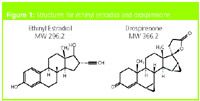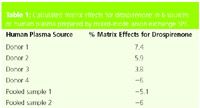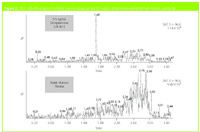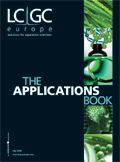A Highly Selective Method for the Analysis of Drospirenone in Human Plasma
The Application Notebook
Several common birth control formulations contain both drospirenone and ethinyl estradiol. A highly selective and sensitive analytical method for the analysis of drospirenone in human plasma has been developed for use in bioequivalence studies. The solid-phase extraction (SPE) and UPLC–MS–MS methodologies are described as well as performance against validation parameters.
Erin E. Chambers and Diane M. Diehl, Waters Corp., Milford, Massachusetts, USA.
Several common birth control formulations contain both drospirenone and ethinyl estradiol. A highly selective and sensitive analytical method for the analysis of drospirenone in human plasma has been developed for use in bioequivalence studies. The solid-phase extraction (SPE) and UPLC–MS–MS methodologies are described as well as performance against validation parameters.
Introduction
The challenges of developing a bioanalytical method revolve around meeting the rigorous criteria set forth in the FDA Guidance for Industry for Bioanalytical Method Validation. Methods need to be acceptable in terms of linearity, sensitivity, selectivity, accuracy and precision, stability and carryover. Recently, the FDA has also included a more comprehensive set of guidelines relating specifically to the assessment and quantification of matrix effects. Effective, highly selective sample preparation is an important component in the minimization of matrix effects and sample variability.

Figure 1
A bioanalytical method for drospirenone, a component of common birth control formulations, was developed to perform bioequivalence studies on generic replacements. Several methods exist for the analysis of ethinyl estradiol,1–5 but this is believed to be the first reported method for drospirenone.

Table 1
We describe sample preparation and chromatographic techniques for the analysis of the two synthetic hormones (drospirenone and ethinyl estradiol), and validation data for the analysis of drospirenone.
In this work, we employ mixed-mode SPE to more selectively separate drospirenone and ethinyl estradiol from matrix components. Subsequent analysis was performed by UPLC–MS–MS. Structures for the analytes are shown in Figure 1.
Experimental Conditions
System: Waters ACQUITY UPLC System with a Waters Quattro Premier Triple Quadrupole Mass Spectrometer operated in positive ion MRM mode
Column: ACQUITY UPLC BEH C18 2.1 × 50 mm, 1.7 µm (Part Number 186002350)
Mobile phase: A: 0.1% HCOOH in water, B: MeOH (drospirenone) or ACN (ethinyl estradiol)
Gradient: 70% A to 98% B over 2 min, hold 0.5 min, reset to initial (3 min total cycle time)
Flow-rate: 0.6 mL/min
Injection: 40 µL
Temperature: 55 °C
Desolvation gas flow: 50 L/hr
Source temperature: 120 °C
Desolvation temperature: 350 °C
Collision cell pressure: 2.6 × 10–3 mbar
MRM transitions: drospirenone 367 → 96.6 ethinyl estradiol 530 → 171
Solid-Phase Extraction (SPE)
SPE device: Oasis MAX, 30 mg 96-well plate
(part number 186000373)
Condition: 500 µL MeOH
Equilibrate: 500 µL water
Load: 250 µL human plasma diluted and acidified 1:1 with 4% H3PO4 in water
Wash 1: 500 µL 5% NH4OH in water
Elute 1: 2 × 125 µL 100% ACN
Elute 2: 2 × 125 µL 2% formic acid in 100% ACN
Directly inject elute 1. Dry down elute 2 and reconstitute in 50 µL of 10 mM sodium bicarbonate buffer, pH 10.5, add 50 µL of 1 mg/mL dansyl chloride solution in acetone and derivatize at 60 °C for 20 minutes.
Results and Discussion
Mixed-mode SPE is highly selective and has been shown to be a very powerful tool in reducing matrix effects for bioanalytical assays.6 As this method is to be used in the determination of bioequivalence, it must meet all of the FDA requirements for validation, including the recent guideline relating to variability of matrix effects. The FDA now recommends that matrix effects be quantified in six sources of matrix and that the variability in matrix effects not exceed ±15%. Variability of matrix effects was determined to be less than ±15% across all sources (Table 1).
We included 4 individual donors and 2 lots of pooled plasma in the analysis to prove that the assay is selective for drospirenone. Minimization of variability across different sources of matrix (i.e., individual subjects in clinical studies), has been a major point of discussion in relation to incurred sample reanalysis (ISR.) Many researchers believe matrix effects arising from sample variability are one of the primary causes for failure in repeat analysis.
SPE recovery was calculated for both drospirenone and ethinyl estradiol. Drospirenone was found in elution 1 (the reversed-phase elution) as expected and ethinyl estradiol was found in elution 2 (bound by anion exchange to the resin). Analyte SPE recovery and RSDs are shown in Table 2.

Figure 2
The method is linear (1/x weighting) for the determination of drospirenone in human plasma from 0.5 to 250 ng/mL. Correlation coefficients were greater than 0.997 and % deviations from the actual concentrations were less than 15%, including at the lower limit of quantification (LLOQ). Sensitivity at the LLOQ of 0.5 ng/mL is shown in Figure 2. Calculated concentrations for QC's at 0.75, 25 and 200 ng/mL were all within 15% of expected values.

Table 2
Conclusion
A sensitive, robust and reliable UPLC–MS–MS method was developed for quantification of drospirenone in human plasma to support a bioequivalence study. Matrix effects were virtually eliminated through the combination of mixed-mode SPE and UPLC–MS–MS. Combining SPE in a 96-well format with 3 minute cycle times yielded sample throughput of over 400 samples a day without compromising data quality.
References
1. N. Twaddle et al., J. Chromatogr. B, 793, 309–315 (2003).
2. H. Licea-Perez et al., J. Chromatogr. B, 8523, 69–76 (2007).
3. M.R. Anari et al., Anal. Chem., 74, 4136–4144 (2002).
4. W. Shou, X. Jiang and W. Naidong, Biomed. Chromatogr., 18, 414–421 (2004).
5. W. Li et al., J. Chromatogr. B, 825, 223–232 (2005).
6. E. Chambers et al., J. Chromatogr. B, 852(1–2), 22–34 (2007).
©2008 Waters Corporation. Waters, The Science of What's Possible, ACQUITY UPLC, UPLC, Quattro Premier and Oasis are trademarks of Waters Corporation.

Waters Corporation
34 Maple Street, Milford, Massachusetts 01757, USA
tel. +1 508 478 2000 fax +1 508 478 1990
Website: www.waters.com

Polysorbate Quantification and Degradation Analysis via LC and Charged Aerosol Detection
April 9th 2025Scientists from ThermoFisher Scientific published a review article in the Journal of Chromatography A that provided an overview of HPLC analysis using charged aerosol detection can help with polysorbate quantification.
Removing Double-Stranded RNA Impurities Using Chromatography
April 8th 2025Researchers from Agency for Science, Technology and Research in Singapore recently published a review article exploring how chromatography can be used to remove double-stranded RNA impurities during mRNA therapeutics production.















